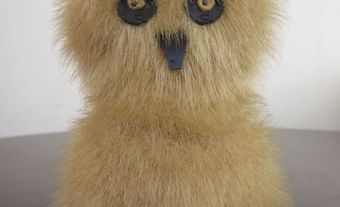
Silver, Church
A large proportion of the silver objects surviving from Canada's colonial years were made for ecclesiastical use. This important legacy of church silver results from the early establishment of the Catholic Church in NEW FRANCE. Laws of the church required that chalices and patens used in the celebration of the mass be made of a noble metal. As gold was too expensive, SILVER was used for these sacred vessels and for many other religious objects. Works of art were encouraged as outward expressions of faith and their beauty was regarded as inspirational.In the 17th century, religious silver was brought to the colonies by missionaries, or sent from patrons in France. The Huron of Lorette, Qué, have an important French reliquary presented to the mission in 1679 and a monstrance of 1664 that originally belonged to the Jesuits. The Jesuits also passed on a Parisian monstrance to the Iroquois at Kahnawake, Qué, and dispersed other, early French-made works to various parishes and institutions. Colonial churches sometimes commissioned silver objects from makers in Paris.
About 1700, as new parishes appeared and prospered, and as the demand for silver works increased, French-trained silversmiths began to immigrate to New France. They taught others the skills of their trade through an APPRENTICESHIP system and passed on their coveted tools. Soon it became faster, safer and cheaper to entrust a local maker with a church commission than to order from abroad. The scarcity of silver was a constant problem and coins or worn-out objects were saved to be melted down and fashioned into new vessels. Much Catholic silver is preserved in early Québec parishes and religious institutions. It is also exhibited at the MUSÉE DU QUÉBEC, the MUSÉE DES BEAUX-ARTS DE MONTRÉAL, the ROYAL ONTARIO MUSEUM, the NATIONAL GALLERY OF CANADA and other art galleries and museums.
The most sacred of the vessels are the chalice, a goblet that contains the wine for the mass, and the paten or plate, used for the blessed wafer or "host." Although these objects are made of silver, the interior surfaces that come in contact with the sacraments are usually gilt. Other church objects were often made of PEWTER, COPPER or brass; these were replaced with silver ones as soon as the parish could afford it. Important pieces include the ciborium, a goblet-shaped, lidded vessel used to hold the host, and the monstrance, which displays the host at the top of its long stem in a small glass lunette surrounded by radiating rays. Other large works in silver are processional crosses, holy-water pails (stoups), sanctuary lamps, candlesticks and ewers. Small birdlike burettes or cruets on trays hold wine and water; censers on chains hold burning incense and navettes store it. Baptismal ewers are tiny, as are lidded containers (ampullae) for holy oils; these articles are often set into boxes for carrying on visitations. Other items are the pyx (a portable ciborium), crucifixes, reliquary crosses and cases. The pax, now dated, is a little plaque formerly kissed by the clergy and congregation during the mass.
The most important silversmiths during the French regime, eg, Paul Lambert, Jean-François Landron and Jacques Pagé, worked in Québec City. Roland Paradis and Ignace-François Delezenne produced religious silver for both the Québec City and Montréal areas. Early makers followed traditional Louis XIV provincial styles, perhaps using local treasures from France for inspiration, but producing their own less elaborate interpretations. Favourite motifs included simple bands of stylized leaves, beads or gadroons, usually offset by smooth surfaces. Decoration was created by embossing, chasing and engraving and sometimes by applying details that had been cast. Rounded shapes were raised with the hammer from flattened sheets of silver and soldered to bases. The stems of chalices and ciboria were made in sections, cast or raised, and screwed together with threaded rods.
Québec City remained the centre of church silver production after the British CONQUEST (1759-60). Here the exceptional François Ranvoyzé created many religious works in a free and decorative style. Among these are 4 gold objects, made for the parish at L'Islet between 1810 and 1812. Laurent Amiot, who returned to Québec in 1787 after studying in Paris, introduced neoclassical elements, reflecting France's newly popular Louis XVI style. Elegant, elongated shapes are decorated with simple reeding, fluting and circular motifs. Smooth surfaces are sometimes engraved with gentle designs; often they are left completely free of decoration. Large sheets of flat silver, introduced about this time, enabled the silversmith to cut and seam hollow parts, instead of raising and hammering them.
There is less early silver from Protestant churches and few of these works are exhibited. Eighteenth-century Anglican churches obtained silver from patrons in England, including royalty. Queen Anne sent plainly elegant chalices, patens, tankard-shaped flagons and alms basins. A communion set she gave to ANNAPOLIS ROYAL is now at St Paul's Church in Halifax. Another set went to the Mohawk in New York; it was later brought to Ontario and is preserved on the Six Nations Reserve near Brantford. George III sent silver to Saint John and Québec City; some of the Québec pieces are in the cathedral there, but 2 are at the St Armand parish in the Eastern Townships. Many forms used in the Anglican Church are similar to Catholic ones, but they tend to be simple in decoration and follow British stylistic traditions. Silver was used in other early Protestant churches but to a lesser degree. Works in the Presbyterian and Methodist churches are very plain and often resemble domestic forms. Communion plate came primarily from Great Britain and the US.
The various churches in the Maritimes received most of their silver objects from France and Britain, but some were made locally. An early Acadian piece is the pyx in Moncton Cathedral, made by Jean Ferment of Québec about 1751. In 1835 John Munro made a pair of silver patens for St Andrews Presbyterian Church in Saint John, NB. In Halifax, Peter Nordbeck and others made beautiful works for Nova Scotia churches from 1820 into the middle of the century.
As the rest of the country was settled and churches were established, most religious silver was imported. By the middle of the 19th century new manufacturing and silver-plating techniques resulted in cheaper wares from abroad. Although Montréal's Robert Hendery and François Sasseville of Québec City made a great deal of church silver, it was increasingly difficult for the individual craftsman to compete. This is still true today, when only a small amount is Canadian made. Protestant churches rely primarily on British and American imports; Catholic churches buy silver from various parts of the world.

 Share on Facebook
Share on Facebook Share on X
Share on X Share by Email
Share by Email Share on Google Classroom
Share on Google Classroom


